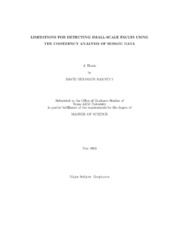| dc.description.abstract | Coherency analyzes the trace to trace amplitude similarities recorded by seismic
waves. Coherency algorithms have been used to identify the structural or stratigraphic
features of an area but the limitations for detecting small-scale features are not known.
These limitations become extremely important when interpreting coherency within
poorly acquired or processed data sets.
In order to obtain a better understanding of the coherency limitations, various
synthetic seismic data sets were created. The sensitivity of the coherency algorithms
to variations in wave frequency, signal-to-noise ratio and fault throw was investigated.
Correlation between the coherency values of a faulted reflector and the known
offset shows that coherency has the ability to detect the presence of various scale
features that may be previously thought to be below seismic resolution or difficult to
discriminate with conventional interpretation methods.
Coherency values had a smaller standard deviation and were less sensitive to noise
when processed with a temporal window length less than one period. A fault could
be detected by coherency when the signal-to-noise ratio was >3. A fault could also be
detected as long as the throw-to-wavelength ratio was >5% or two-way traveltime-toperiod
>10%. Therefore, this study suggests that coherency has the ability to detect
a fault as long as the frequency of the data imaging that fault has a period no greater
than one order of magnitude to the traveltime through the fault and that the signal
can easily be distinguished from noise.
Results from application of the coherency analysis were applied to the characterization
of a very deep fault and fracture system imaged by a field seismic data
set. A series of reverse and strike-slip faults were detected and mapped. Magnitudes
of the throws for these faults were not known, but subtle amplitude anomalies in
seismic sections confirmed the coherency analysis. The results of this study suggest
that coherency has demonstrated an ability to detect features that would normally beoverlooked using traditional interpretation methods and has many future implications
for poorly imaged seismic areas, such as sub-salt. | en |


